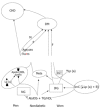Impaired fasting glucose: Pro-diabetic, "atheroprotective" and modified by metabolic syndrome
- PMID: 24147205
- PMCID: PMC3797886
- DOI: 10.4239/wjd.v4.i5.210
Impaired fasting glucose: Pro-diabetic, "atheroprotective" and modified by metabolic syndrome
Abstract
Aim: To investigate whether impaired fasting glucose (IFG) confers cardiovascular risk.
Methods: A non-diabetic population-based sample representative of middle-aged and elderly Turks was studied at 8.5 years' follow-up for incident diabetes and coronary heart disease (CHD). Metabolic syndrome (MetS) was defined by ATP-III criteria modified for male abdominal obesity, and IFG and type 2 diabetes were identified by criteria of the American Diabetes Association. Stratification by presence of MetS was used. Outcomes were predicted providing estimates for hazard ratio (HR) obtained by use of Cox proportional hazards regression analysis in models that controlled for potential confounders.
Results: In 3181 adults (aged 52 ± 11.5 years at baseline), analysis stratified by MetS, gender and IFG status distinguished normoglycemic subjects by a "hypertriglyceridemic waist" phenotype consisting of significantly higher waist circumference, fasting triglyceride and lower high-density lipoprotein-cholesterol, regardless of gender and MetS. Additionally, lipoprotein (Lp) (a) tended to be lower in (especially female) participants with MetS. Multivariable linear regression in a subset of the sample demonstrated decreased Lp (a) levels to be associated with increased fasting glucose and insulin concentrations, again particularly in women. In Cox regression analysis, compared with normoglycemia, baseline IFG adjusted for major confounders significantly predicted incident diabetes at a 3-fold HR in men and only women with MetS. Cox models for developing CHD in 339 individuals, adjusted for conventional risk factors, revealed that IFG status protected against CHD risk [HR = 0.37 (95%CI: 0.14-0.998)] in subjects free of MetS, a protection that attenuated partly in male and fully in female participants with MetS.
Conclusion: IFG status in non-diabetic people without MetS displays reduced future CHD risk, yet is modulated by MetS, likely due to autoimmune activation linked to serum Lp (a).
Keywords: Autoimmune activation; Coronary disease risk; Diabetes, type 2; Impaired fasting glucose; Lipoprotein (a); Metabolic syndrome.
Figures

References
-
- Sarwar N, Gao P, Seshasai SR, Gobin R, Kaptoge S, Di Angelantonio E, Ingelsson E, Lawlor DA, Selvin E, Stampfer M, et al. Diabetes mellitus, fasting blood glucose concentration, and risk of vascular disease: a collaborative meta-analysis of 102 prospective studies. Lancet. 2010;375:2215–2222. - PMC - PubMed
-
- Helfand M, Buckley DI, Freeman M, Fu R, Rogers K, Fleming C, Humphrey LL. Emerging risk factors for coronary heart disease: a summary of systematic reviews conducted for the U.S. Preventive Services Task Force. Ann Intern Med. 2009;151:496–507. - PubMed
-
- Qiao Q, Pyörälä K, Pyörälä M, Nissinen A, Lindström J, Tilvis R, Tuomilehto J. Two-hour glucose is a better risk predictor for incident coronary heart disease and cardiovascular mortality than fasting glucose. Eur Heart J. 2002;23:1267–1275. - PubMed
-
- DeFronzo RA, Abdul-Ghani M. Assessment and treatment of cardiovascular risk in prediabetes: impaired glucose tolerance and impaired fasting glucose. Am J Cardiol. 2011;108:3B–24B. - PubMed
-
- Tominaga M, Eguchi H, Manaka H, Igarashi K, Kato T, Sekikawa A. Impaired glucose tolerance is a risk factor for cardiovascular disease, but not impaired fasting glucose. The Funagata Diabetes Study. Diabetes Care. 1999;22:920–924. - PubMed
LinkOut - more resources
Full Text Sources
Other Literature Sources

